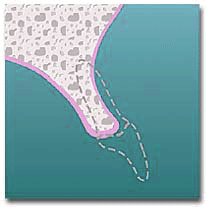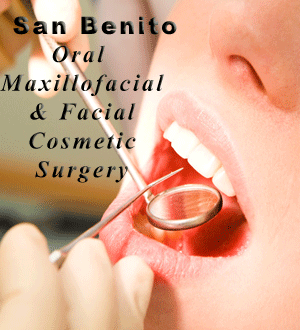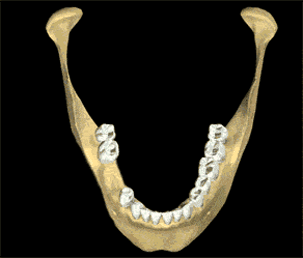Bone graft
A bone graft is surgery to place new bone into spaces around a broken bone or bone defects.
The new bone can be taken from the patient's own healthy bone (this is called an autograft) or from frozen, donated bone (allograft).
A surgeon makes a cut over the bone defect. The bone graft is shaped and inserted into and around the area. The new bone is held in place with pins, plates, or screws. Stitches are used to close the wound. A splint or cast is usually used to prevent injury or movement while healing.
Bone Graft
Sometimes it is necessary to place bone in the area of the planned implant sites. The most common site for the grafts are the sinuses of the upper jaw bone. The bone can be harvested from your chin, hips,ribs or skull. If large amount of bone are necessary, a hospital admission may be indicated for this procedure
Major and minor bone grafting
Over a period of time, the alveolar bone associated with missing teeth atrophies or is reabsorbed. This often leaves a condition in which there is poor quality and quantity of bone suitable for placement of dental implants. In these situations, most patients are not candidates for placement of dental implants. We now have the ability to grow bone where needed. This not only gives us the opportunity to place implants of proper length and width, it also gives us a chance to restore functionality and esthetic appearance.
The bone graft procedures are referred to as:
Sinus Lift Procedure
This procedure involves elevating the sinus membrane and placing the bone graft onto the sinus floor, allowing implants to be placed in the back part of the upper jaw.
Ridge Augmentation
If teeth have been missing for an extended period of time, the respective alveolar ridge (the bone which supports teeth) has been reabsorbed. This leads to a compromised situation, which cannot accommodate the placement of implants. In such cases a bone graft is needed to restore the height and the width on the alveolar ridge prior to implant placement. Traumatic injuries can lead to the loss of teeth as well as their supporting bone. This could possibly compromise the placement of implants in the injured site. The damaged or lost bone can be replaced with a bone graft, thus facilitating the esthetic and functional restoration of the injured site. (back to top)
Nerve Repositioning
The inferior aveolar nerve, which gives feeling to the lower lip and chin, may need to be moved in order to make room for placement of dental implants to the lower jaw. These procedures may be performed separately or together, depending upon the individual's condition. There are several areas of the body, which are suitable for attaining bone grafts. In the maxillofacial region, bone grafts can be taken from inside the mouth, in the area of the chin or third molar region, or in the upper jaw behind the last tooth. In more extensive situations, a greater quantity of bone can be attained from the hip. These surgeries are performed in the out-patient surgical suite under I.V. sedation or general anesthesia.
Do I Have Enough Bone?

After tooth extraction, if the walls of your socket are very thick, they will usually fill with bone in three months. However, if the walls of your socket are very thin (such as in your upper and lower front teeth), then this type of healing will not be as predictable. After waiting three months for the bone to fill in, you may have only a very thin ridge of bone. Sometimes, we place a bone graft at the time of tooth extraction to best aid in your body’s attempt to fill in the socket with bone. This step will maintain the width or volume of bone you’ll need for implant placement and is commonly performed on very thin-walled extraction sockets, especially in such visible areas as the front of the mouth. If your tooth was removed many years ago, then your bony ridge may be extremely thin and you may not have enough bone left for implant placement. In this case, we will place a bone graft next to the thin bone and allow it to heal for three to nine months. After the graft has fused to your pre-existing bone, we will re-enter the ridge and place the implant. Bone grafting is usually a relatively comfortable procedure. We can use many different bone grafting materials, such as man-made bone which we will supply, or we can use your own bone which we can obtain from different areas in your mouth or other donor sites.
Another reason why you may need bone grafting is if the sinus cavities in your upper jaw are very  large or very low and extend into the tooth-bearing areas. This often occurs when teeth in the back of a person’s upper jaw have been removed many years ago and the amount of bone available for implant placement is decreased. This condition requires what we call a "sinus grafting procedure." Most often we will perform this procedure in our office with local anesthesia and sedation if you desire.
large or very low and extend into the tooth-bearing areas. This often occurs when teeth in the back of a person’s upper jaw have been removed many years ago and the amount of bone available for implant placement is decreased. This condition requires what we call a "sinus grafting procedure." Most often we will perform this procedure in our office with local anesthesia and sedation if you desire.
Implant in Place After Sinus Grafting
During this procedure we will locate and elevate the membrane that lines the sinus and will add bone to restore the bone height to ensure that dental implants of an adequate length can be placed at the same time or in the future.
About Us
Dr. Brian Carr holds a both a Dental Degree and Medical Degree. He is a member of the the American Association of Oral and Maxillofacial Surgeons (AAOMS) and a diplomate of the American Board of Oral & Maxillofacial Surgery (ABOMS). Dr Carr is an Associate Clinical Professor at UCSF and has taught facial trauma reconstruction at Zuckerberg San Francisco General Hospital for several years. Dr. McBride has been practicing oral and maxillofacial surgery in the Hollister, California area for over twenty years. He is also a Clinical Assistant Professor in the Department of Oral and Maxillofacial Surgery at University of California San Francisco.Our staff is highly trained and qualified to handle all of your needs. We invite you to come in for a consultation.
We are here to answer your questions, please give us a call at (831) 636-9808 or please use our contact page.
More Information
 Thanks to research breakthroughs, clinical advances and instrumentation innovations pioneered by skin surgery experts, the majority of cosmetic surgeries is now minimally invasive and requires only local or regional anesthesia. This translates into superior patient safety while reducing the all-important "downtime" and recovery period. In addition, new developments and the latest techniques are constantly enhancing the results of many established skin surgery procedures.
Thanks to research breakthroughs, clinical advances and instrumentation innovations pioneered by skin surgery experts, the majority of cosmetic surgeries is now minimally invasive and requires only local or regional anesthesia. This translates into superior patient safety while reducing the all-important "downtime" and recovery period. In addition, new developments and the latest techniques are constantly enhancing the results of many established skin surgery procedures.  Did you know that dental implants are frequently the best treatment option for replacing missing teeth? Rather than resting on the gum line like removable dentures, or using adjacent teeth as anchors like fixed bridgers, dental implants are long term replacements that your oral and maxillofacial surgeon surgically places in the jawbone.
Did you know that dental implants are frequently the best treatment option for replacing missing teeth? Rather than resting on the gum line like removable dentures, or using adjacent teeth as anchors like fixed bridgers, dental implants are long term replacements that your oral and maxillofacial surgeon surgically places in the jawbone.Call our offices at (831) 636-9808
Our experienced and professional office staff members are here to help you with all your questions.
We are conveniently located in Hollister, California in San Benito County at 890 Sunset Drive, Suite B-1A in Hollister, CA 95023. Our telephone number is (831) 636-9808. For driving instructions, click here.
Refer a patient by sending secure referrals, attach X-rays and other documents and communicate securely with our clinic.
Refer a patient to San Benito Oral Surgery
Para más información llame a nuestra oficina
(831) 636-9808
Bienvenidos a la oficina de Dres. McBride y Carr. Una práctica para el tratamiento de problemas de los dientes, las mandíbulas y encara.
Somos situados en el Condado San Benito en 890 Sunset Drive, B-1A, Hollister, CA 95023.


 In just a short time, you can melt the years away from your face, looking natural and refreshed. Dr. Carr can provide temporary improvements, such as botox to more permanent solutions such as a neck lift or facial implants,
In just a short time, you can melt the years away from your face, looking natural and refreshed. Dr. Carr can provide temporary improvements, such as botox to more permanent solutions such as a neck lift or facial implants, 